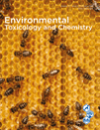Mixture toxicity and interactions of Cu, Ni, Cd and Zn to barley at low effect levels: Something from nothing?
 Mostly, metal contamination comes as a mixture of different metals. These multi-component mixtures can produce significant mixture effects. In this study, metal mixture toxicity on barley root elongation was investigated. Mixture effects of four metals (Cu, Cd, Ni and Zn) were investigated when each metal was present in the mixture at a low effect concentration, i.e. individually only causing a small effect. Two commonly used ‘reference’ models (concentration addition and independent action) were used to test if it is possible to predict toxicity in these mixtures. In this study, it was shown that the toxicity of a mixture of metals was almost always larger than the effect of the most toxic metal in that mixture. In addition, it was found that a mixture of four metals, each causing individually < 10% effect, produced mixture effects up to 50%. This highlights the need to incorporate mixture toxicity in risk-assessment frameworks. Small interactions between the metals relative to both reference models were observed. In general, it was found that concentration addition was the most “safe” (conservative) model, however, independent action was the most “appropriate” (accurate) model.
Mostly, metal contamination comes as a mixture of different metals. These multi-component mixtures can produce significant mixture effects. In this study, metal mixture toxicity on barley root elongation was investigated. Mixture effects of four metals (Cu, Cd, Ni and Zn) were investigated when each metal was present in the mixture at a low effect concentration, i.e. individually only causing a small effect. Two commonly used ‘reference’ models (concentration addition and independent action) were used to test if it is possible to predict toxicity in these mixtures. In this study, it was shown that the toxicity of a mixture of metals was almost always larger than the effect of the most toxic metal in that mixture. In addition, it was found that a mixture of four metals, each causing individually < 10% effect, produced mixture effects up to 50%. This highlights the need to incorporate mixture toxicity in risk-assessment frameworks. Small interactions between the metals relative to both reference models were observed. In general, it was found that concentration addition was the most “safe” (conservative) model, however, independent action was the most “appropriate” (accurate) model.
Scientific abstract
Metal contamination is mostly a mixture of different metals and these multi-component mixtures can produce significant mixture effects. This study was set up to investigate toxicity of multiple metal mixtures of Cu, Ni, Cd and Zn to plants at metal doses individually causing low level phytotoxic effects. Barley (Hordeum vulgare L.) root elongation toxicity tests were performed in resin buffered nutrient solutions to control metal speciation. Treatments included single metal concentrations and binary, ternary and quaternary mixtures. Mixtures of different metals at free ion concentrations each causing <10% inhibition on root elongation, yielded significant mixture effects, with inhibition reaching up to 50%. The independent action (IA) model predicted mixture toxicity statistically better than the concentration addition (CA) model, but some synergisms relative to the independent action model were observed. These synergisms relative to IA were most pronounced in quaternary mixtures and when the dose response curves had steep slopes. Generally, antagonistic interactions relative to the concentration addition (CA) model were observed. Increasing solution Zn concentrations shifted metal interactions (CA based) from additive or slightly synergistic at background Zn concentrations to antagonistic at higher Zn concentrations, suggesting a protective effect of Zn. Overall, this study shows that the CA model can be used as a conservative model to predict metal mixture toxicity to barley. This article is protected by copyright. All rights reserved
Full reference (link)
Versieren L, Evers S, De Schamphelaere K, Blust R, Smolders E. Mixture toxicity and interactions of Cu, Ni, Cd and Zn to barley at low effect levels: Something from nothing?. Environmental Toxicology and Chemistry. Accepted Article
